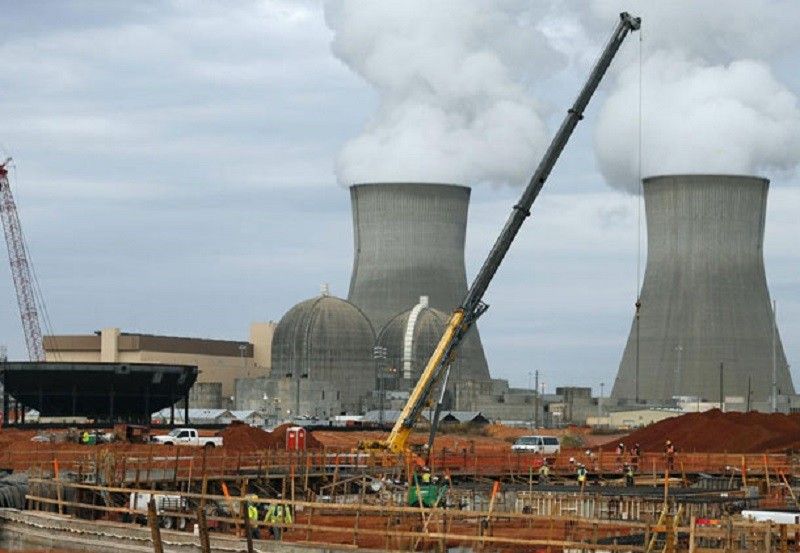Nuclear energy dapat subukan ng 'Pinas — environmentalist

MANILA, Philippines — Hinimok ng isang Amerikanong environmentalist ang Pilipinas na gumamit ng nuclear energy para sa mas mura at ligtas na kuryente.
Sinabi ngayong Miyerkules ng nuclear advocate at presidente ng Environmental Progress na si Michael Shellenberger na makatutulong ito sa kalikasan at pagsugpo ng kahirapan ng bansa.
“In the Philippines, energy is just too expensive. Moving to nuclear electricity gives you cheaper and cleaner energy,” ayon sa TED Talk niya na inilabas sa Facebook live ng Department of Energy.
Aniya, ito ang may pinakamaliit na polusyong nalilikha kumpara sa ibang pinagkukunan ng enerhiya.
Makalilikha rin daw ng mga trabahong matataas ang pasweldo kung sisimulan ito, at makatitipid din ng bilyun-bilyon mula sa pag-aangat ng coal, langis at natural gas.
Mahal, hindi maaasahan, at nangangailangan naman daw ng malaking lugar ang ibang renewable energy sources tulad ng solar at wind.
“Wind and solar don’t generate electricity most of the time. In the Philippines every year, solar generates only 15 percent of the time,” sabi niya.
“So you have to basically pay for electricity twice: for the solar panels and for power plants to operate when the sun is not shining or the wind is not blowing.”
Nanindigan naman si Shellenberger na ito ang pinakaligtas na paraan para gumawa ng kuryente.
“Nuclear energy is the safest way to make electricity. It produces no deadly smoke. While people were scared of Fukushima and other accidents, the only harm was from panic, not radiation, which proves that our fears of nuclear are more dangerous than the technology,” wika niya.
Matatandaang nagkaroon ng nuclear meltdown sa Fukushima, Japan noong 2011 matapos tamaan ng tsunami bunsod ng lindol, dahilan para maglabas ng mapanganib ng radioactive material ang planta.
Sa kasalukuyan, isa ang Pilipinas sa may pinakamahal na kuryente sa Asya at mundo.
“It’s surprising that this thing (nuclear) that we think is most dangerous is, in fact, the safest. This thing that we think kills people actually saves lives. This thing that we associate with the military is actually a tool for peace. This thing that we associate with the past is actually the future,” ayon kay Shellenberger.
Sinabi naman ng DOE na sisirit ang demand para sa kuryente dahil sa patuloy na pagtaas ng populasyon at paglago ng ekonomiya.
“Supply will be tight and demand will be high, and the reserves will be just enough given the scheduled maintenance,” sabi ng Energy department.
Aabot sa 11.2 gigawatts sa Luzon ang demand para sa kuryente ngayong 2019, mas mataas ng apat na porsyento sa 10.8 gw noong 2018 ayon sa DOE.
'Delikado, mahal'
Hindi naman kumbinsido ang ilang sektor sa panukala.
Ayon sa grupong Center for Energy, Ecology, and Development, nagbabadyang sakuna ang pagpapatupad nito sa Pilipinas.
"A nuclear plant, especially one in the Philippines, carries with it a number of hazards whose effects could prove irreversible for a developing country like ours," ayon kay Gerry Arances, executive director ng CEED.
Kontrobersyal ang pagtatayo ng mga plantang nukliyar sa Pilipinas dahil nakapwesto ang bansa sa Pacific Ring of Fire.
"[O]ur geographical location along a typhoon belt and the Ring of Fire threatens to exponentially magnify the risks of pursuing nuclear energy," dagdag ni Arances.
Dati na itong sinubukan ng administrasyon ni Ferdinand Marcos sa pamamagitan ng Bataan Nuclear Power Plant, isang plantang hindi nagamit ni minsan.
Malapit ito sa isang geological fault line at bulkang Pinatubo.
Bukod sa mga trahedya, pinangangambahan din ng grupo ang malilikhang nuclear waste mula sa power reactors.
"This type of waste, being radioactive, poses a threat to the biological integrity of the environment in which it is emitted," babala ni Arances.
Kontra sa pahayag ni Shellenberger, giniit ng CEED na hindi mura ang nukliyar.
"Costs of power plants are almost consistently more than that estimated by the nuclear industry, causing the respective national governments adopting nuclear power to let its nuclear power facilities heavily rely on state subsidies and massive loans, as in the case of India and Finland," giit ng grupo.
Maaaring umasa lang din daw sa mga bansang mayaman sa uranium ang Pilipinas kung ipatutupad ito.
"A more sustainable energy and development path would be pursued if we start tapping into the vast renewable energy of the Philippines, amounting to more than 250, 000 MW of clean energy," panapos ni Arances.
- Latest























